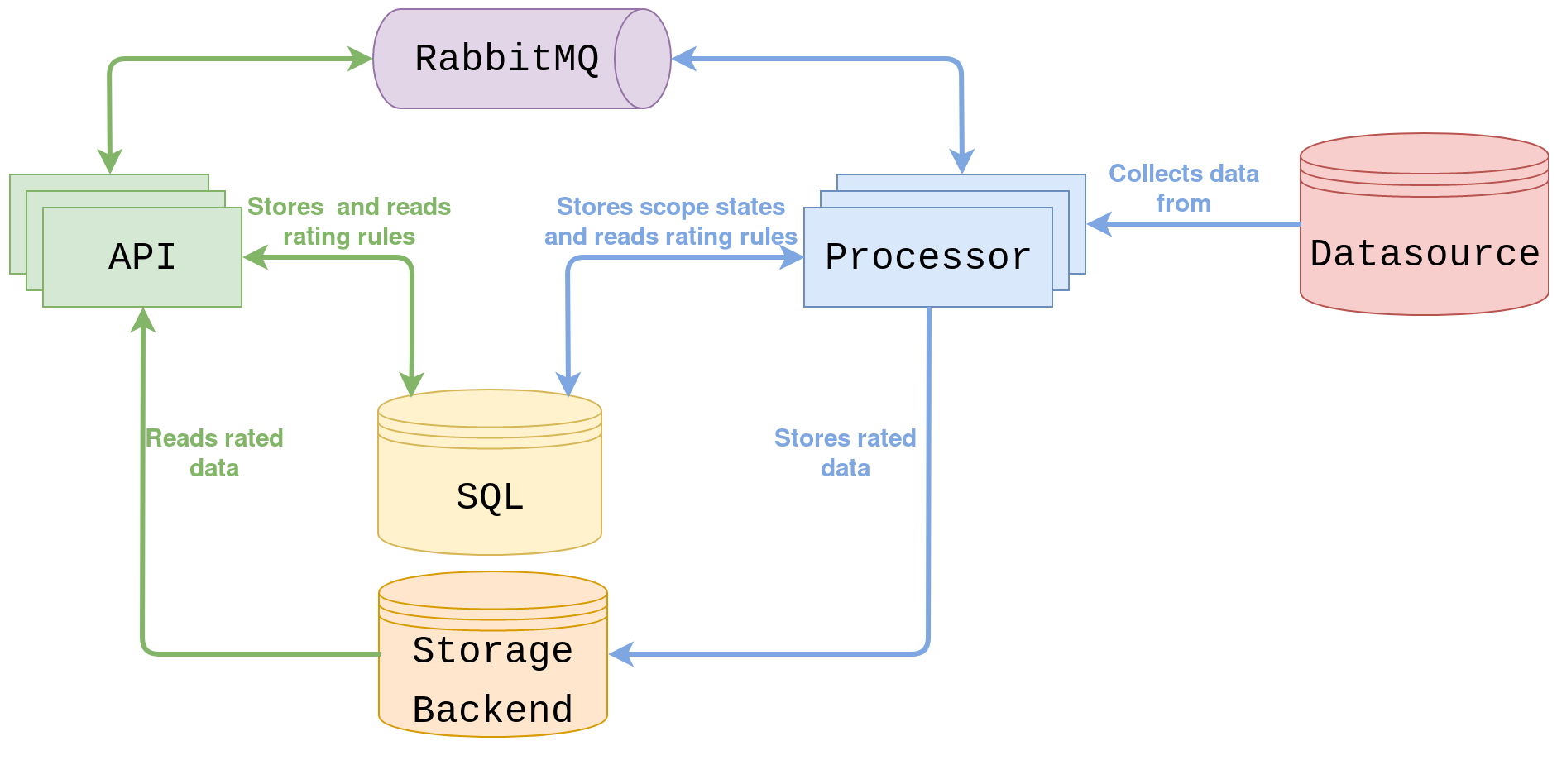CloudKitty’s Architecture¶
CloudKitty can be cut into four big parts:
Data retrieval (API)
Data collection (
cloudkitty-processor)Data rating
Data storage
These parts are handled by two processes: cloudkitty-api and
cloudkitty-processor. The data retrieval part is handled by the
cloudkitty-api process, the other ones are handled by
cloudkitty-processor.
The following is an overview of CloudKitty’s architecture:

For details about the API, see the api reference
The processor falls into the following parts:
The fetcher retrieves a list of scopes to rate. A scope distinguishes and isolates data. It also allows to split the workload between several cloudkitty-processor workers. It can be anything that makes sense in a given context, like an OpenStack project or a Kubernetes namespace.
The collector collects data from a source for a given scope and metric.
The collected data is then passed to the rating modules (several modules can be enabled at the same time). These will apply user-defined rating rules to the collected data.
Once the data has been rated, it is passed to the storage driver, which will store it in a given storage backend. This data will then be available through the API.
Module loading and extensions¶
Nearly every part of CloudKitty makes use of stevedore to load extensions dynamically. The following schema shows the modular parts:

Every rating module is loaded at runtime and can be enabled/disabled directly via CloudKitty’s API. The module is responsible of its own API to ease the management of its configuration.
Collectors, fetchers and the storage backend are loaded at runtime but must be configured in CloudKitty’s configuration file.
Fetcher¶
Five fetchers are available in CloudKitty:
The
keystonefetcher retrieves a list of projects on which the cloudkitty user has theratingrole from Keystone.The
gnocchifetcher retrieves a list of attributes from Gnocchi for a given resource type. This is used for standalone Gnocchi deployments or to discover new projects from Gnocchi when it is used with OpenStack. It can be used in an OpenStack context or with a standalone Gnocchi deployment.The
monascafetcher retrieves from Monasca all values from a configurable metric dimension (project_idby default).The
prometheusfetcher works in a similar way to the Gnocchi fetcher, which allows to discover scopes from Prometheus.The
sourcefetcher is the simplest one: it reads a list of scopes from the configuation file and provides it to the collector.
Details about the configuration of each fetcher are available in the fetcher configuration guide .
Collector¶
There are three collectors available in CloudKitty:
The
gnocchicollector retrieves data from Gnocchi. It can be used in an OpenStack context or with a standalone Gnocchi deployment.The
monascacollector retrieves data from Monasca. Keystone authentication is required for this collector.The
prometheuscollector retrieves data from Prometheus.
Details about the configuration of each collector are available in the collector configuration guide.
For information about how to write a custom collector, see the developer documentation.
Rating¶
Two rating modules are available in cloudkitty (noop is not considered a
real module, as it does nothing). Several rating modules can be enabled at the
same time. Data will be passed to the enabled modules consecutively. The
module priority can be set through the API, and it determines the order in
which they will process the data (modules with the highest priority first).
The
hashmaprating module is the most used one. It allows to create rating rules based on metric metadatas.The
pyscriptsrating module allows to rate data with custom python scripts.
For information about the usage and configuration of rating modules, see the rating modules documentation.
Storage¶
The storage module is responsible for storing and retrieving data from a backend. It implements two interfaces (v1 and v2), each providing one or more drivers. For more information about the storage backend, see the configuration section.
